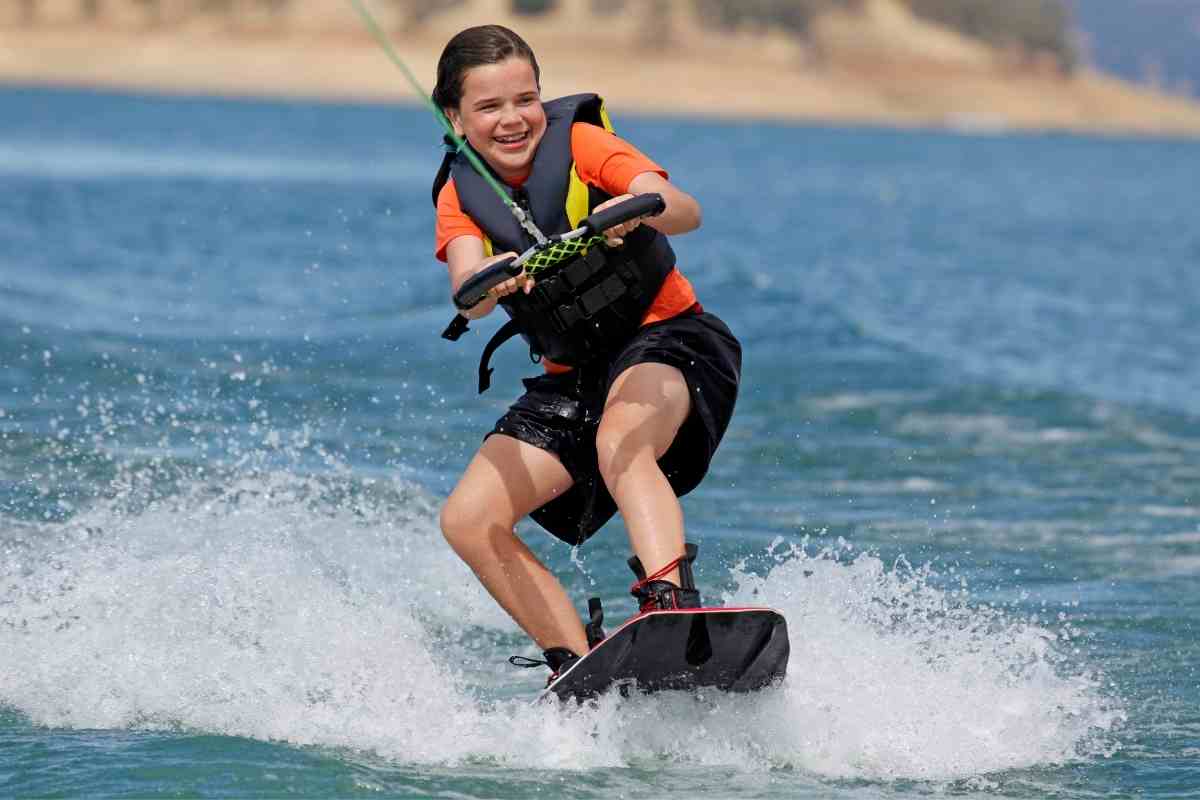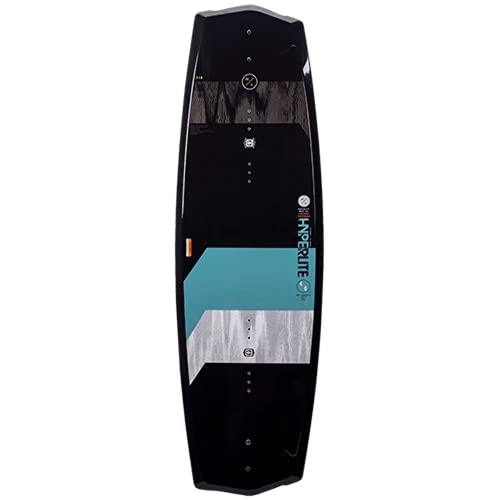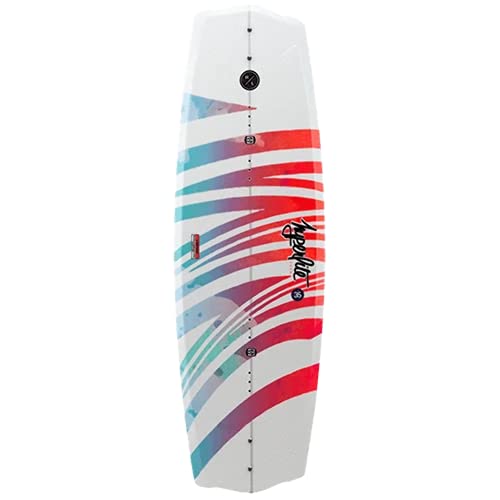Easiest Wakeboard to Get Up On (Get one of these boards)
Wakeboarding has come a long way in a short time. While there’s some debate about the sport’s origins, we can thank the 1980s for its creation. You can enjoy the sport as a rider or a fan, thanks to groups like the World Wake Association tracking rankings and tournaments for both pros and beginners.
Whether you have dreams of going pro someday or want to enjoy the thrill of a new sport, wakeboarding can be a rewarding experience. But it would help if you got up on the board first.
The most challenging skill for wakeboarding or wakesurfing is standing up on the board. Instructors can tell you that succeeding on the first try is about fifty-fifty.
One thing learners neglect is finding the right board. Before you can improve your stunt skills, you need the easiest wakeboard to get up on.
How to Get Up On Your Wakeboard
Try these eight steps for an easier time standing on your board.
- Begin by lying back in the water with your wakeboard parallel with the horizon.
- Bring your knees into your chest. Your ankles should reach your bum.
- Place your arms on either side of your knees.
- Grip the towrope with palms towards the water.
- Maintain this position when the boat starts pulling.
- Maintain strong shoulders and arms as the boat pulls.
- Keep the majority of your weight on your forward foot as the board raises above the water.
- Once upright, distribute your weight evenly and hold the handle near your hip.
Wakeboard Tips
Improper balance contributes to most riders’ concerns with standing up and staying up. We have some tips that will make it easier to get up.
When you assume the crouched, laid-back position, think of it like sitting in a chair. It might seem odd since you’re floating in the water, but use this image to organize your limbs.
Your ankles and knees should be bent but relaxed. While you’ll be engaging your ankles and knees to balance on the water, you don’t want to tense up before. Let the board naturally assume a planed position rather than forcing it. If you stand up too soon, you’ll sink your board.
Repeat this mantra: knees bent. Say it every time you position your board or lean into a turn. It will improve your stability in getting up and riding. Pushing with straight legs will drain your strength more quickly and increase your risk of injury. Getting up on your wakeboard is all about technique, not strength.
Don’t fight the boat. It has more power and will win that tug of war every time. Let that power pull you up instead of pulling you over.
Everyone has a dominant side. You might be more familiar with your pitching arm. It’s the same idea; only the foot you put forward will determine how you steer the board. If your left foot is ahead, this is referred to as regular, while placing your right foot forward is considered goofy.
Don’t assume goofy means your riding incorrectly! It’s the same as being left-handed or right-handed. Regular is more common, but you need to choose the position that’s more comfortable for you. You might need to try a few test rides if you’re unsure.
If at first you don’t succeed, take a break. Getting tired and frustrated isn’t doing you any favors. If your muscles are too tense, you might be adding too much resistance instead of letting the board and the boat doing the work.
You don’t need to start in open water. Rather than exhausting yourself, refocus your efforts on technique.
If there’s a cable park near you, practice there first. Starting from the dock is more manageable, as it gives you a chance to push off from a solid bottom. You’ll increase your chances of a successful first launch.
Choosing a Wakeboard That’s Easy to Get up on
Technique and bended knees are crucial for standing on your wakeboard, but it can be vital to choose a board that works for you. When selecting a wakeboard in the early days of learning, you should seek boards with superior stability and durability.
Some key design specs you should know are length, rocker, and fins. The easiest boards will incorporate designs for predictability over speed and control over height.
You can also choose a board that grows with you. Some elements, like fins, can be changed out. If you want to expand your skills, you might take a chance on a rocker capable of more. Whatever your goals are, start with learning the basics of choosing a wakeboard.
Wakeboard Size
In your search to find the easiest wakeboard to get up on, the most important factor is size. To determine the best length, you need to measure against your weight. Board manufacturers use the metric system, so you’ll need to look up a converter if you’re unfamiliar.
The most common board lengths range from under 130 cm to above 144 cm. If you’re under 100 lbs, it’s best to choose a size under 130 cm. If you’re above 250 lbs, you should choose a board longer than 145 cm. Please take a look at our chart for some standard recommendations.
| Rider Weight (lbs) | Board Size (cm) |
| 25-70 | 111-118 |
| 40-85 | 118-130 |
| 65-110 | 124-134 |
| 70-130 | 130-138 |
| 100-170 | 134-142 |
| 150-225 | 138-146 |
| 170-250 | 142-146 |
| 200-275 | 146 |
You’ll notice there’s some overlap. The range reflects rider preference. When looking at boards that fall within your size range, it’s helpful to know why you should choose shorter or longer.
Shorter means slower because the surface area is smaller. Landings will be more difficult, but aerial maneuvers are more effortless. More experienced riders should choose a shorter size, as it gives them more freedom for tricks.
Beginners or less experienced riders should lean towards longer boards. Longer means more control and a more leisurely ride. The length can make it more challenging to execute tricks or jumps, but you have greater control over movement. With more control, a longer board is the easiest wakeboard to get up on.

Wakeboard Rockers
There are three rocker types plus a hybrid. Each has its purpose, but we only recommend one for the easiest wakeboard to get up on.
Continuous
A continuous rocker provides speed and a smooth ride. The curved shape is the best for newer riders who want a reliable ride. The consistent rocker style offers more control off the wake.
3-Stage
The 3-stage rocker is slower and clunkier. Three angles surfaces result in more height off the wake, making it difficult to maintain balance. If you’re out for aerial tricks, the 3-stage is the rocker of choice. If you’re learning how to stand, only choose a 3-stage rocker on a board with other stabilizing elements.
Camber
The camber style has two surface points, separated by a middle archway, giving it more height than a continuous rocker but not as much as a 3-stage. It also has a touch more speed than the 3-stage. The perk of the camber is that you’ll feel more lightweight in the water.
Hybrid
A hybrid takes elements of all three styles of rockers. The results can vary depending on which aspects of other rockers are incorporated. But you can expect to sacrifice some of the winning features in favor of integrating them all in one.
Like the camber, this can be a helpful middle-ground for riders who want a board with stability but more height capabilities.
Fins
Fins are like a boat’s rudder. They direct your wakeboard’s movement in the water. The thickness of the thins determines how much drag the fins create.
The deeper the fins, the greater your stability. Thinner fins have less grip, which can be more challenging to control but better for executing tricks. You can get boards with removable fins, which allows you to change your fins to match your ability level.
Beginner and intermediate wakeboarders will prefer wider fins as it’s easier to maintain your balance when the board is less slippery. Even experts will choose wider finds in choppy waters.
Easiest Wakeboards to Get up on
Getting up and staying up is the goal of many beginner wakeboards. If you’re a beginner or you need more practice, try these boards.
Hyperlite State 2.0
The Hyperlite State 2.0 removes elements that make mastering the board difficult for newer riders.
The shorter toe-side edge and thin fins create an interesting asymmetrical design. You can have fun with the stronger toe-side bite without losing stability. In a way, the shape informs how you move, helping you transform control motions into instincts if you ever switch to another board.
The abrupt continuous rocker blends the pop a stage 3-stage rocker. You have the drag you need for greater control, but with the ability to add air time. Durable molded-in fins and 1.3-inch center fins keep the board pointed where you want.
Features
- Abrupt continuous blended rocker
- Asymmetrical shape
- Molded-in fins
- Subtle toe-side footbed risers
- Lightweight Biolite 3 core
Hyperlite Eden 2.0
With the same asymmetrical shape as the State, the Hyperlite Eden 2.0 wakeboard construction creates a more durable board with integrated fiberglass layers.
The Eden is for all ability levels, with a thinner profile for looser control and a shape that generates more stability. The continuous rocker allows for a smoother ride but with sharper fins for more speed.
Features
- Abrupt continuous rocker
- Asymmetrical shape
- Molded-in fins
- Subtle toe-side footbed risers
Liquid Force Trip
The Liquid Force Trip is one of Liquid Force’s classic designs. Longer molded fins increase control and stability.
The D-I-S-C hull with edge channels improves control with wide fins. The removable center fin is fantastic for learners. Still, you can easily take off the fin once your ability levels advance.
The aggressive continuous rocker combined with a fuller shape offers riders a bit of pop while still engineered for softer landings. You get both speed and control, making it easier for newer riders to transition from learners to enthusiasts.
Features
- Continuous rocker
- Fits 6-inch bindings
- Variable edge rail
- D-I-S-C hull with edge channels
- Removable center fin
Liquid Force Angel
The Liquid Force Angel, marketed for women, features the same technical specs as the Trip. If you’re looking for a beginner wakeboard that will provide fun as you improve, the Angel has the pop and the control you need.
The aggressive continuous rocker improves performance on bigger wakes. You can expect some kick but with more stable landings.
Features
- Continuous rocker
- Fits 6-inch bindings
- Variable edge rail
- D-I-S-C hull with edge channels
- Removable center fin
Connelly Pure
The Connelly 2021 Pure Wakeboard is an asset for learners hoping for smoother landings.
The mellow 3-stage rocker blends predictability with a kick. You can practice gaining altitude while relying on soft landings.
The central System 80 core with a full spine construction gives you the best of agility and control. The four base molded fins are long for better tracking. The Connelly Pure makes it easier for beginners to get up for the first time and for experts to practice their skills.
Features
- Mellow 3-stage rocker
- Removable center fin
- Four long base molded fins
- System 90 core
Conclusion
Those are our picks for the easiest wakeboard to get up on. While we featured some of the best and most reliable wakeboarding staples, you might have a personal favorite that we missed. What’s your pick for the easiest board for learning how to get up?




